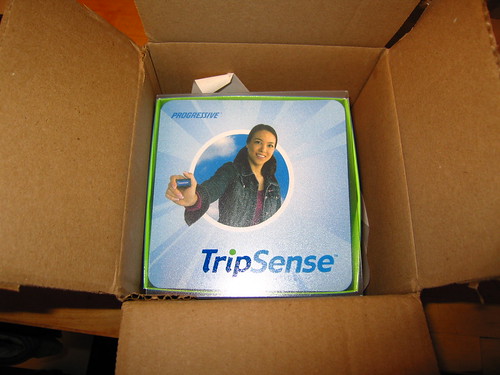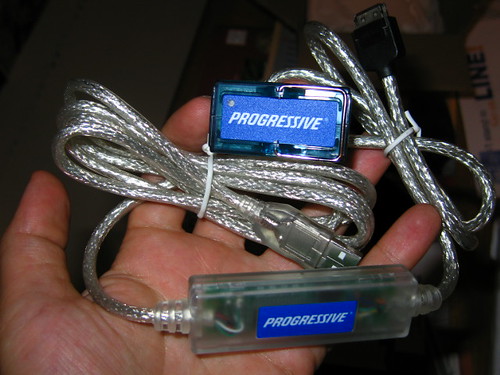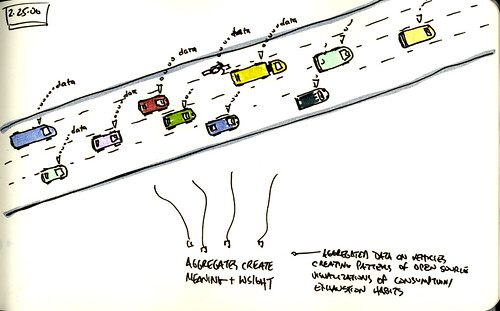I have been pondering with Nicolas and others a series of usage scenarios for Things (networked objects) that could make the aggregate effects of themselves legible through the great disseminator — the Internet. That is, turning things that are invisible and perhaps incomprehensible into the visible and semantically impactful. Since one of my set of stakes in this whole topic is finding design and engineering strategies for encouraging the creation of more sustainable and habitable worlds, I have been focusing on environmental topics to work through some possible scenarios, while also using that topic as a way to become more articulate about how precisely Things (networked objects) and objects that blog might participate in the social web.
Right now, being a slightly reluctant Los Angeles resident, I have focused on these millions of tons of gasoline chugging and toxin exhausting vehicles that race around on highways and streets. You can’t escape them, and you’d be hard pressed to escape participating directly by bringing your own hunk of steel into the mix. It’s so plainly insane. Xeni Jardin helped me find the lynchpin in my early reluctance to buy a car — she said look at it as having an extra room in your house. I screwed my face trying to imagine what extra room I would want, decided it was a laboratory and the decision became a little more palatable.
My car is my laboratory — what is my current experiment?
The experiment now is to think of the vehicle as a miniscule sensor node — like a small speck of “smart dust” that travels down certain predictable routes, disseminating data about where it is, where it has been, how much fuel it has consumed, estimates of how many kilos rubber dust and carbon monoxide and everything else are floating around out there to be breathed.
But not just for my car. For very, very many cars. The “results” of the experiment would be real-time macro-scale RSS content feeds with gdlib generated graphics charts and structured data that can be feed into lovely and semantically impactful Processing and Flash renderings, etc.
The vehicle blog is what it would be. Or the Interstate 405 blog. You could subscribe to a feed and see the aggregate accumulation of this data. It would all be public with identifying traces scrubbed. Or perhaps not — I’d like to see what UPS/FedEx/CSX/USPS — all the big trucking fleets — contribute to this mix. It’s not at all about placing individual blame, but about recognizing the cost of what appears to be “clean” Web 2.0 transcations. Every add-to-cart at Amazon has a cost that exceeds the value of Amazon Prime (I’m a member) I like the no-brainer transaction of Amazon Prime that allows the impulse book buy usage scenario: Oh — I “need” that book right away! Add to cart, complete transaction, done. I pay only for the book — no shipping charges! Who wouldn’t? Or..who would do that so freely when you can actually see the accumulated environmental cost of shipping three separate packages each with one impulse-purchased book, rather than one package of several books ordered once every two or three weeks.
So we could see how much fuel is consumed and how many thousands of kilos of pollutants are wafted into the air and slide down into the acquifer every minute.
Is this a stretch of the imagination in terms of actually executing it? I mean, think of the cost of kitting out even 100 cars to do such an experiment? Forget it. Great sentiment, but — really, this would be hard to do.
Not really.


Several months ago I agreed to participate in some kind of experiment my car insurer was running. They had some operation ship me a device called “Trip Sense.” It plugs into the data port under the steering wheel and just sits there. It’ll sit there for months. It’s accumulating data about my driving. (I’m hoping they cut me a break on my insurance, frankly. I drive very little compared to the typical driver pretty much anywhere — 10k miles and I’ve had the car for 17 months. I’m the “nice old lady from Pasadena, only I’m not old, nor a lady and live in Venice.)
[wikilike_img src=http://www.sparkfun.com/commerce/images/Main-GPS-EM401.jpg|align=thumb tleft|width=265|caption=The EM-401 GPS module from USGlobalSat based on the SiRF II chipset with built-in antenna. Tracks up to 12 satellites with superior reception in urban environments. Includes one 1.75” interface cable. $71.95 at Sparkfun Electronics|url=http://www.sparkfun.com/commerce/product_info.php?products_id=575]
[wikilike_img src=http://www.sparkfun.com/commerce/images/Main-GM862-Python.jpg|align=thumb tright|width=260|caption=This is the recently released Python programmable GM862 module from Telit. Now you can harness all the power of the GM862 without the need for an external microcontroller. Simple Python programs can be loaded onto the GM862 controlling the GPIOs and issuing global cellular commands. $119.95 at Sparkfun Electronics|url=http://www.sparkfun.com/commerce/product_info.php?products_id=279]
It would be trivial to have these little rigs kitted out with a GPS module and GSM telecoms device and it would turn the car into just one of the Blogjects described above.
